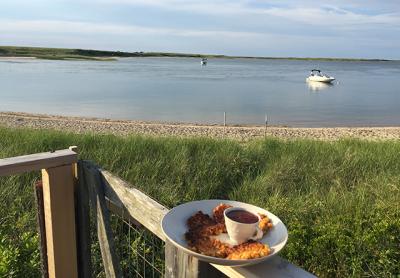Seasons by the Sea: Beyond the Cob

Corn is one of our most precious and plentiful summer treats. Steamed corn on the cob with some good butter slathered all over it is something we look forward to all year, along with that perfectly simple beefsteak tomato sandwich on white bread with mayo.
If straight-up corn on the cob is the Doris Day of summer side dishes, simple and lovely, then Thai corn cakes, Indonesian fritters (dadar jagung), chow-chow, and Mexican street corn are the fiery starlets that steal the show. Isn’t it time you tried some more exotic and unusual methods of serving this most favorite of summer staples?
If you own an ice cream maker, you should make some sweet corn ice cream with chunks of toasted cornbread swirled through it. Serve on corn financiers with a warm blueberry compote. Thai corn fritters served alongside fried fish with sweet chili sauce are a nice change, and the fritters can be made in advance and frozen or refrigerated. Pickle some raw kernels to serve as a relish, fold them into a rich corn pudding to serve with a poached salmon or with a salad for a light lunch or brunch. Mexican street corn is particularly good for barbecues and welcomes many variations on the seasonings and garnishes. For instance, try an Italian version with marjoram, basil, and chives mixed into the mayo, then top with grated Parmesan cheese in place of the cotija cheese.
Corn is one of the plant foods that has to be cultivated and does not grow in the wild. Its closest relative is a grass, and the corn we are familiar with today does not resemble its ancestor “teosinte,” a tiny, hard-shelled pod growing on a stalk thousands of years ago. Scientific evidence shows that early Europeans relied on some form of wheat, fava beans, peas, turnips, onions, radishes, and cabbage. Around 3,500 B.C., corn, beans, hard squashes, tomatoes, and avocados were grown in Central America. Native Americans domesticated nine of the most important food crops in the world, including corn, a.k.a. maize, which now provides over 20 percent of nutrition around the globe.
The archaeological excavation (approximately 10 years ago) of the Balsas region of southern Mexico by botanists from Temple University, the University of Wisconsin, and the Smithsonian Museum of Natural History revealed that people were growing and improving, harvesting and milling, an early form of corn 9,000 years ago. They were also weaving the husks into bedding, clothing, baskets, and toys.
Aside from its more common food uses — masa for making tortillas and tamales, polenta, popcorn, and hominy — corn is also used as animal feed, to make ethanol, cosmetics, corn syrup, laundry starch, alcohol, ink, and even shoe polish.
Once you’ve had your fill of simple, sweet corn on the cob, let it off the leash and try some of these more exotic recipes.
No matter what you make with fresh corn, make sure it is just that, fresh. Keep in mind that as soon as it is picked, the sugar can convert to starch as much as halfway, within a few hours. Same with fresh peas.
Click for recipes
